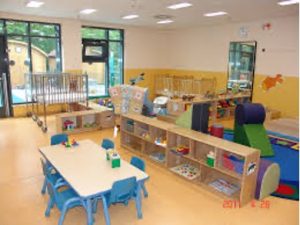 It is not unusual for North Carolina CED professionals to constantly assess elements critical for local economic growth and community enrichment: public-private partnerships, social capital relationships, placemaking, infrastructure needs and available affordable housing are just a few. This week, an issue that has percolated for years has surfaced in a major way – accessible, affordable childcare as a local economic development priority (it has already been a priority for many community development professionals). And as you’ll read in this post, folks from the local North Carolina business community to the Federal Reserve Board are paying attention.
It is not unusual for North Carolina CED professionals to constantly assess elements critical for local economic growth and community enrichment: public-private partnerships, social capital relationships, placemaking, infrastructure needs and available affordable housing are just a few. This week, an issue that has percolated for years has surfaced in a major way – accessible, affordable childcare as a local economic development priority (it has already been a priority for many community development professionals). And as you’ll read in this post, folks from the local North Carolina business community to the Federal Reserve Board are paying attention.
Childcare impacts CED in many important w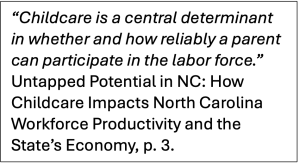 ays, but when considered specifically in an economic development context, it impacts local businesses through workforce availability. On Monday, the U.S. Chamber of Commerce Foundation, in partnership with the NC Chamber Foundation and NC Child released a data and analysis heavy report, Untapped Potential in NC, on the economic impact of barriers to childcare provision to North Carolina businesses. When workers are not able to find accessible, affordable childcare options, the authors found caregivers may have to withdraw from the active workforce, costing North Carolina an estimated $5.65 billion in lost economic activity annually. This figure is based on costs due to absenteeism and employee turnover and lost tax dollars from unearned wages related to barriers to childcare, with a clear description of the underlying assumptions in the report’s economic impact methodology appendix.
ays, but when considered specifically in an economic development context, it impacts local businesses through workforce availability. On Monday, the U.S. Chamber of Commerce Foundation, in partnership with the NC Chamber Foundation and NC Child released a data and analysis heavy report, Untapped Potential in NC, on the economic impact of barriers to childcare provision to North Carolina businesses. When workers are not able to find accessible, affordable childcare options, the authors found caregivers may have to withdraw from the active workforce, costing North Carolina an estimated $5.65 billion in lost economic activity annually. This figure is based on costs due to absenteeism and employee turnover and lost tax dollars from unearned wages related to barriers to childcare, with a clear description of the underlying assumptions in the report’s economic impact methodology appendix.
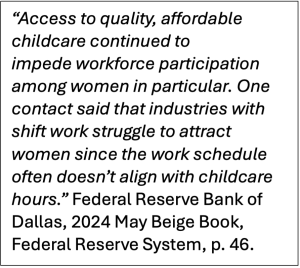 The immediacy of this issue for CED professionals is being driven in part due to upcoming changes in federal funding support for childcare. From 2019-present, the country saw large increases in general funding for the federal Child Care and Development Fund (via the Child Care Development Block Grant), and several rounds of additional funding for childcare in direct response to the COVID pandemic. These funds, estimated at over $52 billion, supported local childcare infrastructure with support for staffing, lower costs to families and organizational stability, providing support of childcare providers and over 300,000 additional childcare placements. The funds tied specifically to COVID response, however, were one-time allocations, and all related funds must be liquidated (actually paid to a provider) by September 30, 2024 – a looming deadline. There also may be related limitations on use of non-COVID child care funding (see Congressional Research Service, What is the Child Care Funding Cliff?). All in all, support for childcare centers across North Carolina may be challenged by the changes in available support in the coming months. It an issue impacting almost every community in North Carolina.
The immediacy of this issue for CED professionals is being driven in part due to upcoming changes in federal funding support for childcare. From 2019-present, the country saw large increases in general funding for the federal Child Care and Development Fund (via the Child Care Development Block Grant), and several rounds of additional funding for childcare in direct response to the COVID pandemic. These funds, estimated at over $52 billion, supported local childcare infrastructure with support for staffing, lower costs to families and organizational stability, providing support of childcare providers and over 300,000 additional childcare placements. The funds tied specifically to COVID response, however, were one-time allocations, and all related funds must be liquidated (actually paid to a provider) by September 30, 2024 – a looming deadline. There also may be related limitations on use of non-COVID child care funding (see Congressional Research Service, What is the Child Care Funding Cliff?). All in all, support for childcare centers across North Carolina may be challenged by the changes in available support in the coming months. It an issue impacting almost every community in North Carolina.
The Federal Reserve is also paying attention. In the March 2023 Beige Book describing economic conditions at the various regional banks, the Federal Reserve Banks in Boston, New York, Philadelphia, Atlanta, Kansas City, Dallas and San Francisco specifically discuss lack of access to affordable childcare as impacting economic activity, either from the perspective of employers facing la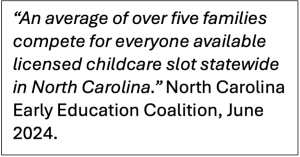 bor shortages in the Labor Market section of each Bank’s report or from the perspective of workers reporting they are unable to actively join the labor force in the Community Conditions section. The most recent Beige Book from May 2024 presented a more mixed picture, with housing affordability, and both a slowdown in hiring and increase in job applications taking general precedence in comments from across the regions. However, the Dallas Region Bank again specifically mentioned childcare (see side bar above), and many of the other Banks emphasized a wide variety of local cost and service access barriers continuing to face middle- to low-income families.
bor shortages in the Labor Market section of each Bank’s report or from the perspective of workers reporting they are unable to actively join the labor force in the Community Conditions section. The most recent Beige Book from May 2024 presented a more mixed picture, with housing affordability, and both a slowdown in hiring and increase in job applications taking general precedence in comments from across the regions. However, the Dallas Region Bank again specifically mentioned childcare (see side bar above), and many of the other Banks emphasized a wide variety of local cost and service access barriers continuing to face middle- to low-income families.
However, there is not universal agreement that childcare costs are having a significant impact on labor force participation – that childcare barriers truly negatively impact people’s participation in the workforce overall. A study published in 2023 by economists from the St. Louis Federal Reserve Bank showed just such a connection but only for women with a partner. For other groups, especially for men, the connection between childcare and workforce participation was not clearly supported.
On the other hand, while showing childcare is not a major barrier to some groups, the study did reinforce the findings that for a significant group of women with children, being able to access childcare meant the difference between working and not. A recent article using qualitative data collected from low-income mothers in Colorado, Georgia and Massachusetts from 2009 to 2020 supported this concept – it revealed how the “constant, underlying threat of the loss of income and unsafe conditions for children influences childcare and work decisions, hindering their ability to move out of poverty even when employed.” (Freeman, A. 2024. Impossible arrangements: The extreme challenge of child care for low‐income mothers. The American Journal of Economics and Sociology.)
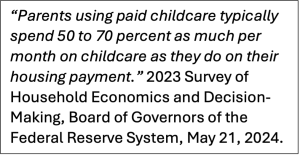
The issue is not going away. There will be more focus on the impact of childcare in the future. The Federal Reserve Board’s Survey of Household Economics and Decision-making now includes childcare questions. Results from the 2023 survey published this past May show childcare costs can make up a substantial share of the family budget, as highlighted in a short Federal Reserve Bank video. Childcare will be a key part of the CED picture going forward at all levels.
Special thanks to Bri Frink, MSW, MPA Candidate UNC School of Government for her research and review contributions to this blog.
Copyright © 2009 to Present School of Government at the University of North Carolina.



